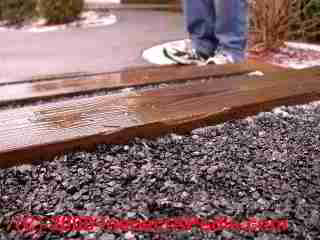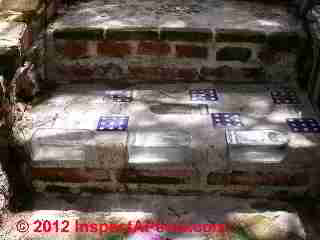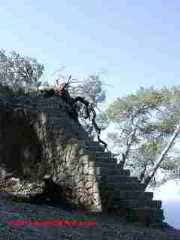 Exterior Stairway & Walkway Trip & Fall Hazard
Exterior Stairway & Walkway Trip & Fall Hazard
Stair defect photos
- POST a QUESTION or COMMENT about how to recognize, prevent, or correct common slip, trip, or fall hazards on exterior stairs & walkways.
Outdoor or exterior building stair and step & walkway trip and fall hazards are described and illustrated with photographs of bad designs, inadequate maintenance, or other hazards that can lead to trip and fall injuries outdoors on and around buildings.
We discuss dilapidated stair structures: rot, loose connections, pitched, wobbly, missing parts, collapse risk; unsafe landscape-tie or railroad tie step and walk tripping hazards; slip trip fall defects in masonry steps and landings outdoors; slippery exterior stair surfaces: glass & tile; curved, tall, or uneven stair fall hazards; clandestine trip and fall hazards at low decks & platforms; algae, ice, fungus, & other stair slip, trip & fall hazards.
We illustrate common trip points and we describe good practices for safe stairs and walks outdoors. We include a discussion of the role of stair railings or handrails and stair fall injuries, and we also discuss the role of wood species, wood treatment, and maintenance in exterior stair fall injuries.
InspectAPedia tolerates no conflicts of interest. We have no relationship with advertisers, products, or services discussed at this website.
- Daniel Friedman, Publisher/Editor/Author - See WHO ARE WE?
Guide to Common Exterior Stair Slip Trip & Fall Hazards
 Dilapidated Stair Structures: rot, loose connections, pitched, wobbly, missing parts, collapse risk
Dilapidated Stair Structures: rot, loose connections, pitched, wobbly, missing parts, collapse risk
This article focuses on slip trip and fall hazards on exterior stairs, landings, platforms, decks, balconies & their railings. 5
While in general the building code specifications for exterior stairs, landings, and railings are the same as for indoor star is, we often see special trip hazards at exterior stairs and walks, conditions that do not occur indoors, and details which may escape some building inspectors.
[Click to enlarge any image]
Our page top photo of a scary stair to nowhere was photographed by the author (DF) in Majorca in 2002. At left we document a collapsing wood stairway observed in Maine.
And some stair design requirements, such as stair treads that will not hold water, naturally pertain principally to outdoor stairways.
Unsafe Landscape-tie or railroad tie step and walk tripping hazards
Here we add some more subtle warnings about outdoor stairs and stair construction, and tips or tricks of carpentry and masonry to avoid problems with stairs.
It's common for gravel, dirt, or asphalt to settle inside of the step perimeter made of landscape ties such as shown in our photo.
When the wood projection is 1/8" or more above the other walking surface (asphalt in this photo) it's a tripping hazard that should be corrected.
- Landscape tie stair edges raised
above brick or stone interior - trip hazard (photo above
These steps are also wet, adding a naturally-occurring slip, trip, and fall risk that may combine with or even be mistaken for the actual cause of a fall here - catching the toe of one's shoe on the raised landscape tie during passage down these steps.
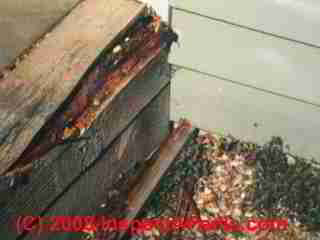 ...
...
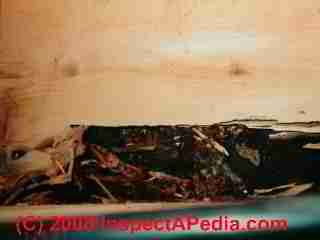
- Landscape tie stair components rotted,
especially at the nose edge of the steps add to trip and fall hazards both by forming a soft surface that can be penetrated by sharp high heels, or by leading to movement or settlement of the steps or walkway - Landscape tie or railroad tie steps abutting a building
are an invitation to insect damage and rot as we found at this Connecticut condominium belonging to an aide to Henry Kissinger.
The owner spent enough time traveling that s/he did not notice the roof spillage at the front entry (note the exposed gravel in the left photo), and the builder did not consider that bringing the vinyl siding into ground contact gave a protected and inviting path for insects to enter the structure.
The right-hand photo above shows the rotted and carpenter-ant demolished rim joist in the basement of this structure just inside the exterior stair.
Slip Trip Fall Defects in Masonry Steps and Landings Outdoors
Masonry stairs have of course been constructed and used for quite a while, even pre-dating modern building code and safety associations and legal remedy should the stair user fall.
At the Pyramid of the Sun outside of Mexico City (DF 2011) the stairs to the pyramid top are very tall and very steep and with a high rise. They are easier to ascend (below left), than to descend (below right - the author is in the blue shirt).
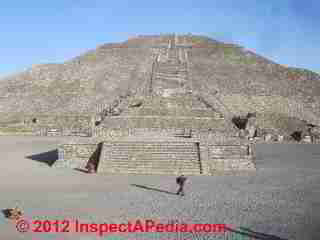 ...
... 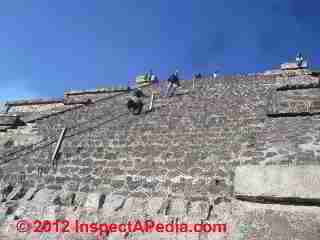
- Masonry stair treads should be slightly pitched
away from the riser in order to drain water away from the riser side of the step - you don't need much pitch to drain, 1" in 45" of run is sufficient and won't violate building code.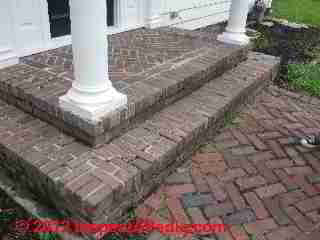
Good drainage on a masonry stair (or walk) also reduces damage from frost-related surface spalling and cracking.
- Masonry stairs should be protected from frost
heaves by proper gravel, backfill, drainage, and other construction details.
Our brick steps photograph (above left) illustrates loose bricks at the nose of an exterior stair - a likely trip and fall hazard. Low stairs such as these may be excluded from local building code requirements for a handrail, but nevertheless they can form a serious tripping hazard.
At below left we illustrate solid stone masonry stairs that are frost-damaged, pitched (photo, Justin Morrill Smith Historic Site, Strafford VT). These stone steps are more than 100 years old and have been left "as is" for historic reasons.
They are a tripping hazard. And even properly sized solid stone stairs can become a trip hazard after 100 to 150 years of foot traffic such as the stairs shown at below right. These steps are in the Hacienda Jaral de Berrio and date from the 1700s.
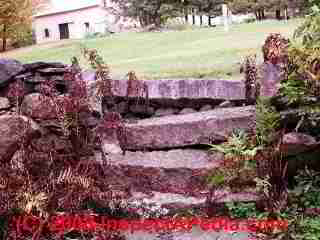 ...
...
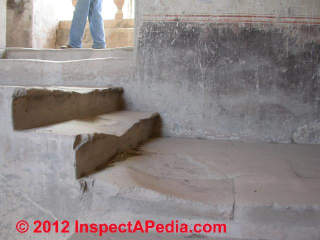
Slippery Exterior Stair Surfaces: glass & tile
Exterior stairs are slippery when coated with algae (discussed below), wet leaves, iced or snow: that's obvious.
But other sources of slippery exterior stairs include use of particular materials that become particularly slippery when wet.
At above left we illustrate a more subtle stairfall hazard in these otherwise creative stairs designed by a Guanajuato artist. The use of glass bottles at the stair tread nose provides a surface that will be quite slippery when wet.
See details at TILED WALKING SURFACE SLIP HAZARDS
Curved, Tall, or Uneven Stair Fall Hazards

Stair steps that are curved like these steps we photographed in Tucson Arizona can be tricky to use and in our OPINION are a trip and fall hazard
Stair Landings onto a Sloped Surface May be Fall Hazards
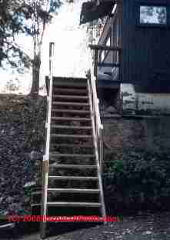
Stair steps that terminate at a sloped surface where there is not room for a level platform present a complex of problems.
At above left is an exterior stair that I [DF] was in the process of constructing along with Art Cady. The treads were level and well supported with deep cleats; the railings are incomplete.
But the termination of the steps on a slope required not only custom-cut stringers and special measures for stair support, it also gave us a stair landing problem.
The bottom landing is at a narrow driveway that slopes. Had we included an appropriate stair landing platform, passage along the narrow drive became a problem for vehicles.
The stair had other issues - notice the incomplete and discontinuous hand railings.
A technically-correct solution for these stairs may have been an intermediate platform and a turn of the stairs to the right, continuing descent through a cut-away portion of the hill, ending on a level platform that in turn stepped onto the sloping drive. Still the user ends by stepping off of a level platform onto a slope.
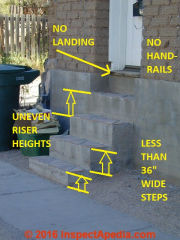
Stair steps that have a high and/or uneven rise like these steps we photographed (also in Tucson) violate building stair code standards for uniformity (more than1/4" difference in step rise) are a trip and fall hazard.
This building entry also lacks an entry platform and the steps lack a handrail.
Clandestine Trip and Fall Hazards at Low Decks & Platforms
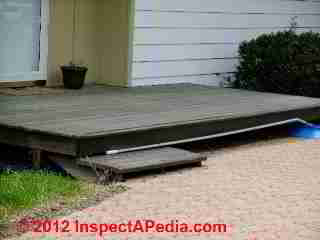
Stair steps at the edge of a low entry platform, deck or patio like the step shown at left may comply with the letter of building codes in may areas - there are only two steps and the total height of the platform is less than 36" above ground.
But we see the following trip and fall hazards at this location
- There is a significant difference in riser height between the two risers
- The bottom step is sloped and curved
- The bottom step does not extend the width of the upper platform, but there no visual clue to inform someone walking down that they might step off of the platform where there is no step at all
- The electrical conduit is a bit odd and perhaps adds to a trip hazard as well as being something less than beautiful (lack of beauty is not generally a trip slip or fall hazard)
Examples of Causes of Exterior Stair Collapse & Fall Injury Hazards
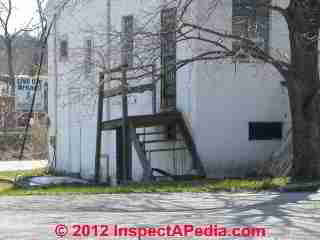
Causes of Collapses at Wooden Exterior Stair Steps & Rails
Because a stairway collapse can occur suddenly and without warning to the stair users, injuries on these steps can be particularly egregious. Our photographs illustrate and we list below many of the common causes of collapsing exterior wooden stairs. Contact us to suggest additions to this material.
- Improper original construction of the stairs, including improperly set & secured supporting stair structure or posts, use of improper fasteners (drywall screws, rust-prone nails, non-structural fasteners, undersized structural connectors) and failure to properly secure the stairway to the building it serves
- Wood rot or insect damage at supporting posts, joists, stair platform, stair treads, stair tread cleats, including failure to treat cut ends of pressure treated posts leading to post sinking or collapse.
In our photo at above left some of the stair treads broke near the tread center, railings were omitted or have fallen away, upper stair platform railing is unsafe and lacks balusters, posts are leaning and loose, the platform is tilted, and on closer inspection a variety of other defects and hazards was evident.
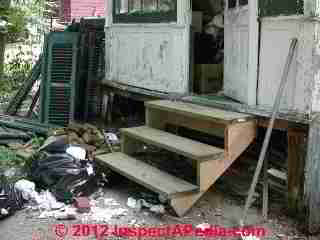
- Excessively deep notches into the stair stringer that carries stair treads can lead to a catastrophic break and failure of the whole stairway.
While we like the idea of supporting the treads on top of a notch into the stair stringer (in some regards it's potentially a stronger support than using stair tread brackets or cleats) the very deep notches cut into the 2x stair stringer in our photo left about three inches of wood to carry the weight of the stairs.
In sum, instead of a 2x12 carrying the weight of the stairs, the stair support has been reduced to a 2x4.
Of course there are quite a few other troubling conditions at the stairs in our photo.
- Improper or inadequate support of stair tread supports or stair stringers such as failure to connect the stair stringer to the building with adequate fasteners (shown below), or as shown in our photo at left, construction of stair treads on unstable supports with no connections whatsoever.
In our photograph, the stone stair treads are a nice material, but at just stacking stone treads on a vertical clay block has created the following hazards:
- The door swings out over a step
- a platform is required here - The right end of the stair treads rests on the ground with no connection
to secure against lateral or other movement of the treads, and in a northern climate, exposing the treads to frost heaves and sloping hazards. - The left end of the stair treads rests on insecure clay blocks
that lean and tip (as the treads are not secured), and also the clay block itself is at risk of crushing, frost damage, collapse. - There is no level landing area
from the bottom step. - Check out this closeup PHOTOgraph of the tipping deteriorating clay blocks supporting these steps.
- Improper or inadequate connection of stair structure to the building.
Failure to connect the stair stringer to the building at all (photo at left) or inadequate connection can lead to a sudden and horrible surprise as the entire stair structure can fall down or slip away from the building.
Stairs are usually connected to the building at the top or head of the stair stringers using structural connectors, perhaps in combination with a ledger board between the interior surfaces of the stringers.
If the stairs ascend a building side wall, the stair stringer on that side is also often connected to the building wall for added support and stiffness.
What's holding the steps in place (photo at left) is that concrete apron at lower right in our photo.
Take a closer look (click to see an enlarged image of any photo or sketch in our articles) and you can see that the stair stringer has just a corner in contact with the building and the step treads slope down towards the sidewalk.
Add the absence of a hand railing, uneven step rise, possible algae on the step surface, a curved bottom stair tread of different height, and we've got multiple conditions asking for a stair slip trip and fall accident at this Hudson New York building.
- Improper / inadequate connection of stair treads to stair stringers
can lead to sudden collapse of the individual stair tread. Notice the collapsed stair treads in our photo above. Some stair builders secure the stair treads only by nailing through the side of the stair stringer and into the end-grain of the tread itself.
In our photo the stair treads are supported on 2x4 cleats nailed to the stair stringer. It looks like two 12d common galvanized nails were used.
Is this enough? Click to enlarge the photo and notice that the cleats on the outer stringers must have been through-bolted to the stringer (see the bolt heads) - a more secure connection.
Too many nails can be as bad as too few in wood frame construction, as excessive nailing splinters and destroys the wood connection.
End nailing of stair treads through the stringer
is an inadequate support for the tread and is exceptionally dangerous (as the author has experienced).
Watch out: When an end-nailed stair tread breaks away from the stringer (the tread surface splits or the stringers separate from the treads), the tread falls away leaving a sharp nail end extending into the walking area exactly where it can rip open a walker's ankle or leg in the course of the stair fall.
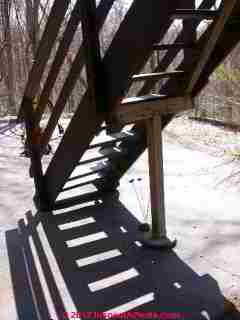
- Inadequately supported long stair runs
leave the stairway shaky and wobbly, possibly contributing to loosening of the structural connectors of the stair and also adding to the slip trip and fall risk for such stairs.
A common shortcut on long stairs, visible in our photo, is the failure to carry an intermediate stair railing newel or post down to the ground.
Carrying an intermediate post to a footing in the ground will add stiffness and support to the stairs.
See details at NEWEL POST CONSTRUCTION
Algae, Ice, Fungus, Wet Surfaces Can Cause slips and falls on stairs
Algae growth on steps or decks: green or sometimes black algae grows readily on wood, concrete, or stone surfaces in most climates, particularly where those surfaces are repeatedly wet and especially if the surface is also shaded.
Algae makes these walking surfaces dangerously slippery when wet - a slip, trip and fall hazard which is widely recognized. [29][30][31][32]
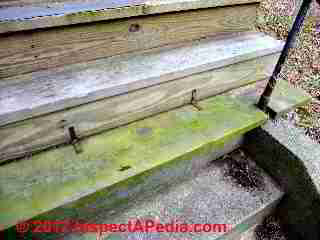 ...
... 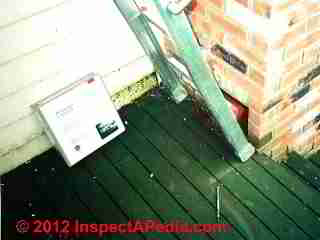
The steps at left and deck at right were inspected by the author who in fact nearly had a bad fall due to wet algae on the deck where the ladder was placed.
You can see the scrape marks of the ladder feet (where my pen is pointing in the photo, above right) and the good luck that the ladder slippage was stopped by the chimney base.
It is readily observed that algae growth on wood surfaces may seem harmless when the steps are dry, but when any stair surface, stone, brick, wood, or other, is covered with algae and becomes wet, the surface is extremely slippery, adding significantly to the risk of a serious fall and injury.
Snow & Ice on Exterior Ramps, Stairs, or Walks is a Serious Fall & Injury Hazard
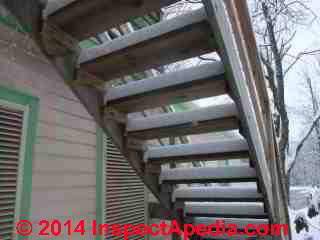 Failure to keep exterior walking surfaces free of ice and snow is discussed extensively in literature on fall hazards in climates where freezing conditions occur.
Failure to keep exterior walking surfaces free of ice and snow is discussed extensively in literature on fall hazards in climates where freezing conditions occur.
Some particularly helpful research citations on snow and ice slip trip and fall hazards are given just below.
Snow and ice may cause or contribute to very serious falls and falls that may be witnessed by more people - as the walker is outdoors - than indoor slips, trips and falls that may occur where the field of view for second-party observers is more limited.
See SNOW & ICE REMOVAL on WALKS & STAIRS where we discuss approaches to making these walking surfaces more safe.
...
Continue reading at SLIPPERY STAIRS, WALKS, ROOFS where we discuss the coefficient of friction on various walking surfaces under various conditions as well as anti-slip stair and walk or ramp construction recommendations from building codes and standards, or select a topic from the closely-related articles below, or see the complete ARTICLE INDEX.
Or see these
Reommended Articles
- ACCESSIBLE DESIGN
- ADA STAIR & RAIL SPECIFICATIONS
- ELDERLY & VETERANS HOME SAFETY
- GRABRAIL GRAB BAR SPECIFICATIONS
- HANDRAILS & HANDRAILINGS
- HALTING WALK STAIR DESIGNS for LOW SLOPES or SHORT STEP RISE
- SLIP TRIP & FALL HAZARD LIST, STAIRS, FLOORS, WALKS
- SLIPS, TRIPS & FALLS, EXTERIOR STAIRS
- SLIPPERY STAIRS, WALKS, ROOFS
- SNOW & ICE REMOVAL on WALKS & STAIRS
- STAIR CODES & STANDARDS - downloads
- STAIR CONSTRUCTION IDEAL DIMENSIONS
- STAIR DESIGN for SENIORS
- STAIR DESIGNS for UNEVEN / SLOPED SURFACES
- STAIR DIMENSIONS, WIDTH, HEIGHT
- STAIR PLATFORMS & LANDINGS, ENTRY
- STAIR RAILS, STAIR GUARDS
- STAIR TREAD NOSE SPECIFICATIONS
- STAIR USER FOOT & HAND PLACEMENT
- TILED WALKING SURFACE SLIP HAZARDS
Suggested citation for this web page
SLIPS, TRIPS & FALLS, EXTERIOR STAIRS at InspectApedia.com - online encyclopedia of building & environmental inspection, testing, diagnosis, repair, & problem prevention advice.
Or see this
INDEX to RELATED ARTICLES: ARTICLE INDEX to STAIRS RAILINGS LANDINGS RAMPS
Or use the SEARCH BOX found below to Ask a Question or Search InspectApedia
Ask a Question or Search InspectApedia
Try the search box just below, or if you prefer, post a question or comment in the Comments box below and we will respond promptly.
Search the InspectApedia website
Note: appearance of your Comment below may be delayed: if your comment contains an image, photograph, web link, or text that looks to the software as if it might be a web link, your posting will appear after it has been approved by a moderator. Apologies for the delay.
Only one image can be added per comment but you can post as many comments, and therefore images, as you like.
You will not receive a notification when a response to your question has been posted.
Please bookmark this page to make it easy for you to check back for our response.
IF above you see "Comment Form is loading comments..." then COMMENT BOX - countable.ca / bawkbox.com IS NOT WORKING.
In any case you are welcome to send an email directly to us at InspectApedia.com at editor@inspectApedia.com
We'll reply to you directly. Please help us help you by noting, in your email, the URL of the InspectApedia page where you wanted to comment.
Citations & References
In addition to any citations in the article above, a full list is available on request.
- Best Practices Guide to Residential Construction, by Steven Bliss. John Wiley & Sons, 2006. ISBN-10: 0471648361, ISBN-13: 978-0471648369, Hardcover: 320 pages, available from Amazon.com and also Wiley.com. See our book review of this publication.
- Eric Galow, Galow Homes, Lagrangeville, NY. Mr. Galow can be reached by email: ericgalow@gmail.com or by telephone: 914-474-6613. Mr. Galow specializes in residential construction including both new homes and repairs, renovations, and additions.
- [3] Stephenson, Elliott O., THE ELIMINATION OF UNSAFE GUARDRAILS, A PROGRESS REPORT [PDF] Building Standards, March-April 1993
- [4] "Are Functional Handrails Within Our Grasp" Jake Pauls, Building Standards, January-February 1991
- [5] Access Ramp building codes:
- UBC 1003.3.4.3
- BOCA 1016.3
- ADA 4.8.2
- IBC 1010.2
- [6] Access Ramp Standards:
- ADA (Americans with Disabilities Act), Public Law 101-336. 7/26/90 is very often cited by other sources for good design of stairs and ramps etc. even where disabled individuals are not the design target.
- ANSI A117.4 Accessible and Usable buildings and Facilities (earlier version was incorporated into the ADA)
- ASTM F 1637, Standard Practice for Safe Walking Surfaces, (Similar to the above standard
- [7] The Circular Staircase, Mary Roberts Rinehart
- [8] Construction Drawings and Details, Rosemary Kilmer
- [9] Falls and Related Injuries: Slips, Trips, Missteps, and Their Consequences, Lawyers & Judges Publishing, (June 2002), ISBN-10: 0913875430 ISBN-13: 978-0913875438
"Falls in the home and public places are the second leading cause of unintentional injury deaths in the United States, but are overlooked in most literature. This book is unique in that it is entirely devoted to falls. Of use to primary care physicians, nurses, insurance adjusters, architects, writers of building codes, attorneys, or anyone who cares for the elderly, this book will tell you how, why, and when people will likely fall, what most likely will be injured, and how such injuries come about. " - [11] The National Institute of Standards and Technology, NIST (nee National Bureau of Standards NBS) is a US government agency - see www.nist.gov
- "A Parametric Study of Wall Moisture Contents Using a Revised Variable Indoor Relative Humidity Version of the "Moist" Transient Heat and Moisture Transfer Model [copy on file as/interiors/MOIST_Model_NIST_b95074.pdf ] - ", George Tsongas, Doug Burch, Carolyn Roos, Malcom Cunningham; this paper describes software and the prediction of wall moisture contents. - PDF Document from NIS
- [12] Slips, Trips, Missteps and Their Consequences, Second Edition, Gary M. Bakken, H. Harvey Cohen,A. S. Hyde, Jon R. Abele, ISBN-13: 978-1-933264-01-1 or ISBN 10: 1-933264-01-2, available from the publisher, Lawyers ^ Judges Publishing Company,Inc., www.lawyersandjudges.com sales@lawyersandjudges.com
- [13] Slips, Trips, Missteps and Their Consequences, Gary M. Bakken, H. Harvey Cohen, Jon R. Abele, Alvin S. Hyde, Cindy A. LaRue, Lawyers and Judges Publishing; ISBN-10: 1933264012 ISBN-13: 978-1933264011
- [14] The Stairway Manufacturers' Association, (877) 500-5759, provides a pictorial guide to the stair and railing portion of the International Residential Code. [copy on file as http://www.stairways.org/pdf/2006%20Stair%20IRC%20SCREEN.pdf ] -
- [17] Steps and Stairways, Cleo Baldon & Ib Melchior, Rizzoli, 1989.
- [18] The Staircase, Ann Rinaldi
- [19] Common Sense Stairbuilding and Handrailing, Fred T. Hodgson
- [20] The Art of Staircases, Pilar Chueca
- [21] Building Stairs, by pros for pro, Andy Engel
- [22] A Simplified Guide to Custom Stairbuilding, George R. Christina
- [23] Basic Stairbuilding, Scott Schuttner
- [24] The Staircase (two volumes), John Templar, Cambridge: the MIT Press, 1992
- [25] The Staircase: History and Theories, John Templar, MIT Press 1995
- [26] Steps and Stairways, Cleo Baldon & Ib Melchior, Rizzoli, 1989.
- [27] "The Dimensions of Stairs", J. M. Fitch et al., Scientific American, October 1974.
- [28] Stair & Walkway Standards for Slipperiness or Coefficient of Friction (COF) or Static Coefficient of Friction (SCOF)
- ANSI A1264.2
- ANSI B101
- ASTM D-21, and ASTM D2047
- UL-410 (similar to ASTM D-21)
- NSFI 101-B (National Floor Safety Institute)
- NSFI Walkway Auditing Guideline (WAG) Ref. 101-A& 101-B (may appear as ANSI B101.0) sets rules for measuring walkway slip resist
- OSHA - (Dept of Labor CFR 1910.22 does not specify COF and pertains to workplaces) but recognizes the need for a "qualified person" to evaluate walkway slipperiness
- ADA (relies on the ANSI and ASTM standards)
- [29] A. Sacher, International Symposium on Slip Resistance: The Interface of Man, Footwear, and Walking Surfaces, Journal of Testing and Evaluation (JTE), ISSN: 1945-7553, January 1997 [more focused on slipperiness of polished surfaces
- [30] Algae is widely recognized as a slippery surface - a Google web search for "how slippery is algae on steps" produced more than 15,000 results on 8/29/12)
- [31] Slipperiness of algae on walking surfaces, warning, Royal Horticultural Society, retrieved 8/29/2012, original source: http://apps.rhs.org.uk/advicesearch/profile.aspx?pid=418
- [32] Slipperiness of algae: "Watch your step, wet rocks and algae are slippery" Oregon State University warning 1977 retrieved 8/29/2012, original source: http://www.worldcat.org/title/watch-your-step-wet-rocks-and-algae-are-slippery/oclc/663683915
- [33] Coefficient of friction of algae on surfaces [like stair treads]: Delphine Gourdon, Qi Lin, Emin Oroudjev, Helen Hansma, Yuval Golan, Shoshana Arad, and Jacob Israelachvili, "Adhesion and Stable Low Friction Provided by a Subnanometer-Thick Monolayer of a Natural Polysaccharide", Langmuir, 2008 pp 1534-1540, American Chemical Society,
retrieved 8/29/2012,
Abstract: Using a surface forces apparatus, we have investigated the adhesive and lubrication forces of mica surfaces separated by a molecularly thin, subnanometer film of a high-molecular-weight (2.3 MDa) anionic polysaccharide from the algae Porphyridium sp. adsorbed from aqueous solution. The adhesion and friction forces of the confined biopolymer were monitored as a function of time, shearing distance, and driving velocity under a large range of compressive loads (pressures). Although the thickness of the dilute polysaccharide was less than 1 nm, the friction was low (coefficient of friction = 0.015), and no wear was ever observed even at a pressure of 110 atm over 3 decades of velocity, so long as the shearing distances were less than twice the contact diameter. Atomic force microscopy in solution shows that the biopolymer is able to adsorb to the mica surface but remains mobile and easily dragged upon shearing. The adhesion (adsorption) of this polysaccharide even to negatively charged surfaces, its stable low friction, its robustness (high-load carrying capacity and good wear protection), and the weak (logarithmic) dependence of the friction force on the sliding velocity make this class of polyelectrolytes excellent candidates for use in water-based lubricant fluids and as potential additives to synovial fluid in joints and other biolubricating fluids. The physical reasons for the remarkable tribological properties of the ultrathin polysaccharide monolayer are discussed and appear to be quite different from those of other polyelectrolytes and proteins that act as thick “polymer brush” layers. - [34] Jinjin Li, Yuhong Liu, Jianbin Luo, Pengxiao Liu, and Chenhui Zhang, "Excellent Lubricating Behavior of Brasenia schreberi Mucilage" Langmuir 2012 28 (20), 7797-7802
- [35] Jason R. Stokes, Lubica Macakova, Agnieszka Chojnicka-Paszun, Cornelis G. de Kruif, and Harmen H. J. de Jongh, "Lubrication, Adsorption, and Rheology of Aqueous Polysaccharide Solutions, Langmuir 2011 27 (7), 3474-3484
- [36] "Coefficients of Friction for Ice", The Physics Factbook™, Glenn Elert, Ed., retrieved 8/29/12, original source: http://hypertextbook.com/facts/2004/GennaAbleman.shtml
- [37] "Coefficients of Friction for Ice", The University of the State of New York Reference Tables for Physical Setting/Physics. New York: The State Education Department, 2002. Op. Cit.
- [38] Serway Physics for Scientists and Engineers 4th edition (p. 126.)
- [39] "How Slippery Is It", retrieved 8/29/12, original source http://www.icebike.org/Articles/howslippery.htm
- [40] John E. Hunter, "Friction Values", The Source, Society of Accident Reconstructionists, Winter 1998. Study of frictional values of car tires involved in collisions on snow or ice covered roadways.
- [41] Frictional Coefficients of some Common Materials and Materials Combinations, The Engineering Toolbox, retrieved 8/29/2012, original source: http://www.engineeringtoolbox.com/friction-coefficients-d_778.html [copy on file as Friction and Coefficients of Friction.pdf ]
- [42] Stairways and Ladders, A Guide to OSHA Rules, OSHA, U.S. Department of Labor, 3124-12R 2003 - Web Search 05/28/2010 original source: http://www.osha.gov/Publications/osha3124.pdf. OSHA regulations govern standards in the construction industry and in the workforce Quoting from OSHA whose focus is on workplace safety and so excludes discussion of falls and stair-falls in private homes:
OSHA estimates that there are 24,882 injuries and as many as 36 fatalities per year due to falls from stairways and ladders used in construction. Nearly half of these injuries are serious enough to require time off the job--11,570 lost workday injuries and 13,312 non-lost workday injuries occur annually due to falls from stairways and ladders used in construction. These data demonstrate that work on and around ladders and stairways is hazardous. More importantly, they show that compliance with OSHA's requirements for the safe use of ladders and stairways could have prevented many of these injuries. - osha.gov/doc/outreachtraining/htmlfiles/stairlad.html
- [43] International Building Code, Stairway Provisions, Section 1009: Stairways and Handrails, retrieved 8/29/12, original source: http://www.amezz.com/ibc-stairs-code.htm [copy on file as IBC Stairs Code.pdf]
- [44] Model Building Code, Chapter 10, Means of Egress, retrieved 8/29/12, original source: http://www2.iccsafe.org/states/newjersey/NJ_Building/PDFs/NJ_Bldg_Chapter10.pdf, [copy on file as NJ_Bldg_Chapter10.pdf] adopted, for example by New Jersey. International Code Council, 500 New Jersey Avenue, NW, 6th Floor, Washington, DC 20001, Tel: 800-786-4452
- Our recommended books about building & mechanical systems design, inspection, problem diagnosis, and repair, and about indoor environment and IAQ testing, diagnosis, and cleanup are at the InspectAPedia Bookstore. Also see our Book Reviews - InspectAPedia.
- Best Practices Guide to Residential Construction, by Steven Bliss. John Wiley & Sons, 2006. ISBN-10: 0471648361, ISBN-13: 978-0471648369, Hardcover: 320 pages, available from Amazon.com and also Wiley.com. See our book review of this publication.
- Decks and Porches, the JLC Guide to, Best Practices for Outdoor Spaces, Steve Bliss (Editor), The Journal of Light Construction, Williston VT, 2010 ISBN 10: 1-928580-42-4, ISBN 13: 978-1-928580-42-3, available from Amazon.com
- In addition to citations & references found in this article, see the research citations given at the end of the related articles found at our suggested
CONTINUE READING or RECOMMENDED ARTICLES.
- Carson, Dunlop & Associates Ltd., 120 Carlton Street Suite 407, Toronto ON M5A 4K2. Tel: (416) 964-9415 1-800-268-7070 Email: info@carsondunlop.com. Alan Carson is a past president of ASHI, the American Society of Home Inspectors.
Thanks to Alan Carson and Bob Dunlop, for permission for InspectAPedia to use text excerpts from The HOME REFERENCE BOOK - the Encyclopedia of Homes and to use illustrations from The ILLUSTRATED HOME .
Carson Dunlop Associates provides extensive home inspection education and report writing material. In gratitude we provide links to tsome Carson Dunlop Associates products and services.


